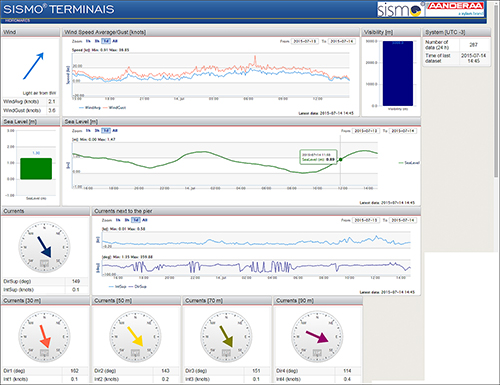Jul 23, 2015Wave height, current and depth can impact a ship's ability to navigate through a port. So can temperature and salinity, which affect a boat's buoyancy and thus its hull's position in relation to the seabed. Traditionally, navigators and port managers, who help guide ships into and out of ports, have had to rely on personal observations of these phenomena. But sensors mounted underwater and on buoys can provide localized, real-time measurements to supplement this empirical knowledge and help a port remain more productive and safer for ships than it would be without this data, according to Gabriel Paschoal, the sales director of HidroMares, a company that provides oceanography consulting and technology solutions to Brazilian port managers.
HidroMares' real-time weather-oceanographic information system, known as SISMO (Sistema de Informações Meteo-Oceanográficas—or oceanographic meteorological information system in English), monitors waves, currents and water depth, as well as temperature and salinity levels, in order to help ports improve navigation safety, streamline ship traffic and increase productivity. The company uses a range of sensors from American company SonTek and Norwegian firm Aanderaa.

Because radio waves do not easily propagate underwater, the sensors mounted beneath the ocean surface are linked via cable to buoys and pier structures, where radio modems provided by Brazilian manufacturer Duodigit transmit the data, via an embedded Gemalto Cinterion machine-to-machine (M2M) module, to a cloud-based server over a cellular link.
To create the SISMO user interface, HidroMares collaborated with Aanderaa, a division of Xylem, a firm that provides technology services related to water resource management. Port workers use computers to access the HidroMares application via Aanderaa's servers, enabling them to view a dashboard that shows all of the metrics being tracked in real time. These include wind direction, wind speed, sea level, visibility, and the direction and speed of ocean currents.
According to Alexandre De Caroli, HidroMares' technical director, one difficult aspect of building out the port-monitoring system was establishing reliable links between the sensors and the cloud-based application. As such, the ruggedness of the Duodigit modems and the reliability of the Gemalto modules are key to the solution's success.
So far, the HidroMares SISMO system has been deployed at Porto do Açu (Port of Açu), in the Brazilian city of Rio de Janeiro, an important logistics hub for Brazil's oil and gas production in the Campos Basin.

